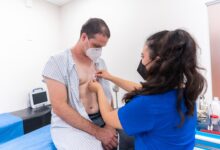
Adenomegaly is the increase, painful or not, in the size of a lymph node. This enlargement is often caused by bacterial or viral infections. In rarer cases, it can be linked to the presence of tumors.
Adenomegaly, how to recognize it
Etymologically, adenomegaly means the increase in the size of the glands. This term comes from the Greek, “adên” which means “gland” and “megas” which means large.
Adenomegaly, what is it ?
Adenomegaly is therefore an enlargement of the lymph nodes, also called lymph nodes, following an infection by a virus, bacteria or parasite. They are sometimes (but more rarely) linked to a tumour.
The lymph nodes are nodules arranged along the lymphatic vessels, in certain regions of the body. Several adenopathies exist:
- Mediastinal adenomegaly: swelling of the lymph nodes in the thorax region (between the two lungs, near the heart, trachea, bronchi and esophagus).
- Cervical adenomegaly: enlargement of the cervical lymph nodes (located in the neck, in the cervical lymph node areas).
- Axillary adenomegaly: this concerns the lymph nodes located under the armpits.
- Inguinal adenomegaly: the increase in the size of the inguinal lymph nodes (located at the level of the groin).
- bridge
- Allergies (overview)
- Achluophobia : all about the fear of the dark
- At what age can you do bodybuilding?
- Fatigue in the morning: causes and remedies
How to recognize adenomegaly ?
Enlarged lymph nodes are most often discovered by the doctor. It is on palpation that the doctor can detect abnormal growths in these lymph nodes.
The patient may sometimes feel the appearance of a small “lump” or “mass” in the armpits, neck or groin, sometimes accompanied by fever.
Other methods potentially confirm the diagnosis, such as ultrasound and other types of imaging tests.
For example, in the thorax, these mediastinal adenopathies are localized thanks to thoracic computed tomography. Depending on the area concerned, the diagnosis can be obtained by:
- mediastinoscopy (examination of the mediastinum through an endoscope);
- mediastinotomy (incision of the mediastinum);
- thoracoscopie.
Finally, a study of the cells by histology makes it possible to determine the character of malignancy or not of the adenopathy.
Risk factors
Immunocompromised people are at greater risk of infections. Patients with HIV or patients on immunosuppressive therapy, for example, are at greater risk of hypertrophy.








